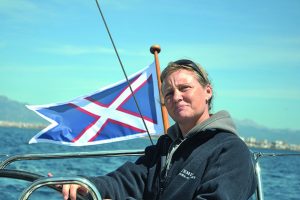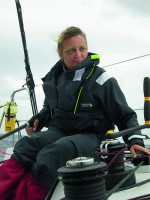Pip Hare explains the challenges of navigating when sailing short-handed and offers tips on how to plan ahead
Navigating when sailing short-handed can be an often-overlooked challenge. It can throw up stressful situations, particularly when it is the responsibility of just one member of the crew, navigating in unfamiliar waters when probably tired.
One solution is to create a road book. This is a concept used extensively by the French short-handed racing community and basically condenses all the crucial or stressful parts of your intended passage into one easy-to-understand document that can be shared between co-skippers.
Before you depart spend a couple of hours virtually ‘walking the course’ bringing together all your passage planning tools, tidal atlases, weather routeing tools and charts (paper or electronic).
Break your passage into legs or phases and for each one try to work out what the navigational hazards or pinch points might be, when will you need to change sails and what information you might need to have close to hand in addition to your charts.
Road book
My typical road book will contain: a list of legs with bearing, distance and sail selection, zoomed in screen shots of areas with tight navigation – normally these will have a lat and long grid marked on them and I will have annotated them with a felt tip pen – tidal charts, boat polars and a sail cross over chart when racing, entry or pilotage diagrams for arrival/finish.

Extract from Pip’s road book showing hazards at Land’s End
When sailing single-handed I print and laminate all these details so that I can take them on deck with me.
Though a lot of navigational software will allow you to access this information from one computer screen, it still takes time to retrieve or double check information, meaning one person will have to leave the deck at what quite often could be a stressful time.
It is also often the case that one crewmember is significantly better at ‘driving’ the software, which can be a problem if they are off-watch asleep, or even feeling unwell. The process of creating the road book will make you more prepared for any navigational challenges and enable both crew to access vital information quickly.
Waypoints
Input all chart plotter waypoints before leaving the dock and keep a list of waypoint names or numbers in your road book; it is really easy to make input errors when under pressure or tired.
It is important both crew have a bigger picture of the course and don’t simply follow a line on the chart plotter, particularly if using a plotter on deck and at night time.
Use a chinagraph pencil to write memory prompts on the side of the cockpit to keep continuity during watches – eg ‘ When wind shifts to 200 tack’ or ‘depth no less than 9m’. If you don’t want to write on your boat, get a small whiteboard to keep in the cockpit.
Always translate distance into time, especially when communicating with your co-skipper, as this will allow you both to prepare mentally for manoeuvres and understand when you may be approaching risky situations. Again this is particularly important at night time – eg ‘We have another 20 mins on this course then we must tack to avoid the coast’ or ‘We must have the spinnaker down in two miles, which gives us 15 mins at this speed’.

Quick tips
- Think course first then speed – make the position and the direction in which you are travelling a priority at all times.
- Keep a speed, distance, time graph by the chart table to convert distance to time easily.
- Discuss ‘what if’ scenarios before going off watch so both co-skippers are able to take immediate action with confidence.

Single-handed ocean sailor Pip Hare has clocked up thousands of miles racing and cruising. Among her achievements are five solo transatlantics, including the OSTAR and two Mini Transat races. She also works full-time for the RNLI on sea safety and is Consulting Editor on Yachting World. See her gear test on weather routeing packages
See also Pip’s fascinating series on advanced sailing techniques: SAIL FASTER SAIL SAFER




